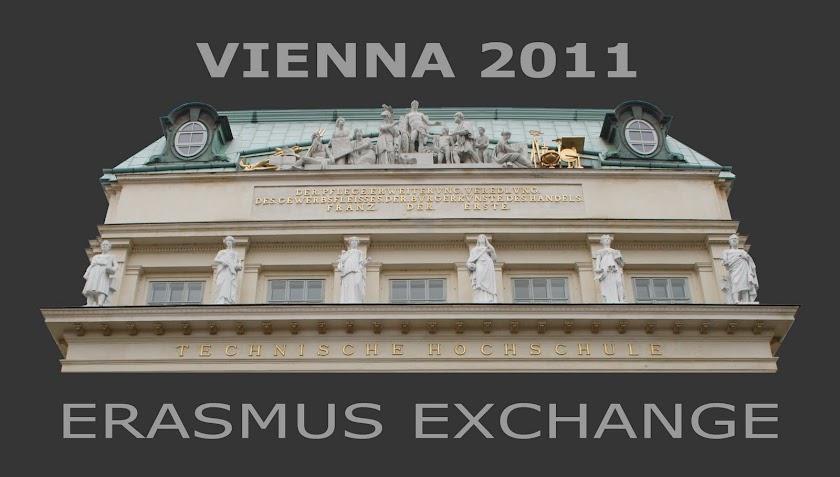Seeing as it was raining today it was definitely a wise choice to go to the Albertina Museum to see the Mel Ramos, Roy Lichtenstein and Der Blaue Reiter exhibitions. Ellen and her sister who was visiting Vienna also wanted to go so we travelled together.
The Albertina entrance at Ground Level with the Wiener Staatoper in the background
The Albertina Museum in the rain at First Floor Entry Level
The first exhibtion we went to was 'Mel Ramos - Girls, Candies and Comics'. Mel Ramos was an important artist in the Pop Art movement; on display were many of his paintings and preliminary sketches from his early comic imagery such as Wonder Woman to his famous commercial pin-ups. His stylish approach and clever use of depicting brands in a stylish and sexy style was a reflection of American culture and consumerism. The larger than life popular images were all very well executed and well presented in the exhibition. I personally found his ‘Salute to Art History’ the most interesting. He had taken a number of nude pictures by classical masters and represented these using modern poses and figures. Although my initial reaction to the exhibition was not great I began to appreciate his artistic qualities, techniques and development.
The second exhibtion was 'Roy Lichtenstein - Black & White 1961-1968'. Roy Lichtenstein’s iconic imagery is known across the world. He was also inspired by advertising, consumerism and the popular cultures of the 1960’s; over a number of years he began to refine his technique of painting down to a very graphical and impact driven style. What made Lichtenstein interesting was taking subjects and objects from every day life into art. His aim to draw people’s attention to things that would never have thought to have been art – and turning into art, was very successful. Although now like so many famous artists and architects before us, his thought process has been forgotten by many. In my opinion what made his work special was his unique thinking and choice of subject that had never been done previously; now that so many people repeat and reproduce work in his style has really made these more recent works meaningless. We have seen this with the use of glass and steel being taken from Mies van de Rohes ideas of purity and light and being ravaged by the commercial market as a technique of producing buildings quickly and cheaply.
I thoroughly enjoyed the exhibition and was intrigued by the details and complexity of some of his images. I studied his work previously but seeing it at first hand has once again reinforced my respect for him and my appreciation of less sometimes being more.
The main attraction for me to visit the Albertina had been to see 'Der Blaue Reiter - From the Lenbachhaus and the Albertina'. Der Blaue Reiter (the Blue Rider Group) was a group of artists who all followed similar artistic ideas, it is said that the name came from Franz Marc’s love for horses and Kandinsky’s enthusiams for riding, combined with the idea of blue being the colour of spirituality and unity in their work and in the world. Der Blauer Reiter, alongside the Cubists and Futurists are some of my favourite groups and movements in art. I was heavily influenced by these in my art work at school and up to the present day. The range of techniques and approaches from the group is astonishing but unlike many other movements most of the artists had very different styles.
The exhibition had works from August Macke, Franz Marc, Marianne von Werefkin, Alexej von Jawlensky, Wassily Kandinsky, Robert Delaunay, Heinrich Campendonk, Gabriele Münter, Paul Klee, and Alfred Kubin. The common theme of all these artists was the common desire to express spiritual truths through their art works. Each section of the exhibition revealed works that I had never seen or associated the group to previously. There were clear connections to music, nature, life and death; with all of the results drawing me into understanding the movement even more. I was impressed and in some cases even a little disappointed with some individual pieces but as a collection and seeing it all together was incredible.
My highlight was seeing Franz Marc’s works. His dreamy images and in some cases very complex compositions seemed to sooth and slow the pace of the exhibition down after moving through the Klee and Kandinsky sections. In particular my favourite pieces were actually the smallest and most subtle compositions in the form of postcards that Marc had written to the likes on Kandinsky and Kubin. His expert application of paint and refinement of detail on the 10x15 bits of card really captured the essence of the group and the relationships within it.
I left with a spring in my step and itching to get drawing. Overall each exhibition was a wonderful experience but for me the series of Kandinsky, Klee and Marc were the most moving. Seeing the doodles, sketches, paintings and prints that were clearly meant for nothing but the artist’s pleasure was a real honour to see.
The Wiener Staatoper from the First Floor Entry Level of the Albertina Museum




























